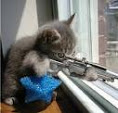You may have seen photos of an aircraft carrier conducting flight operations with a smaller ship trailing behind. That ship was functioning as the "plane guard", a term that was often contracted to a single word: Planeguard.
The destroyer (it was usually a destroyer, but after the FRAM-DDs were all retired, it often fell to a Knox or Perry class FF) followed behind the carrier during flight operations. The job of the planeguard was to pick up the flight crew of an airplane that crashed on launch or recovery.
Planeguard was developed after the Second World War. It wasn't done during the war, likely because of the risk of a stopped escort being torpedoed by a Japanese submarine. The accident rate on board carriers in the early days of the jet age, especially before the angled-deck was adopted fleet-wide, was horrendous by modern standards.
The planeguard DD followed the carrier around at a distance of 500 yards. While the pilots undoubtedly liked the idea of someone coming to save their asses, having a ship with a tall radar mast so close to the stern of the carrier wasn't liked, especially when the straight-deck carriers were still in use.
The destroyers didn't much care for it, either. They didn't like that the carrier engineers didn't seem to give a shit whether or not a ship was behind them when the carrier snipes pumped bilges. Because nothing pleased the destroyers' engineers more than running contaminated water through their evaporators. The word also almost always seem to be passed on the carrier to secure flight ops and dump all trans and garbage from the fantail before the planeguard was cut loose from her station.
And there was also a concern that following too closely gave the planeguard little time to react if the carrier abruptly changed course or, worse, slowed down without signalling those changes to the planeguard. Over time, the planeguard was moved back to a thousand yards, then to a station two thousand yards off the port quarter of the carrier (2SNX) or three thousand yards (3SNX).
Planeguard sucked, especially at night. Carriers have lots of deck lighting, it was almost impossible to pick out the running and range lights, and so it was very hard to determine whether or not a carrier changed course or speed. If radar silence was ordered, then keeping track of what the carrier was doing could be very difficult.
Aircraft carriers really did had a nasty habit of changing courses and speeds in order to maintain favorable winds across their decks without notifying their escorts of that. Talk to anyone who ever stood a OOD or JOOD watch on a tin can on planeguard and they'll tell you stories. No true destroyerman liked planeguard duty. It was not uncommon for either the Captain or the XO to be on the Bridge of ships in planeguard station.
The dangers weren't theoretical. HMAS Melbourne collided with and sank two of her escorts, HMAS Voyager and USS Frank E. Evans. USS Wasp ran over USS Hobson and sank her. There were quite a few other collisions between carriers and their escorts.
The use of tin cans for planeguard largely went away for three reasons. One was that helicopters could do the job much faster. The second was that there were far fewer escorts available. An escort that had good passive sonar capability was needed far enough away to detect an enemy submarine and do something about it, rather than trying to follow a carrier without getting run over. The same logic held true for AAW missile shooters. The third reason was that the accident rate for naval aviation really decreased, especially after the mirror landing system was adopted and adjusted to.
(Yes, they do it with mirrors.)
Praying
20 hours ago


2 comments:
Spent more than a few hours behind a bird farm, on a real DD too. We were still plane guarding in the mid 70's.
About the "real DD", it was the Turner Joy DD-951 last gunship. All guns, no missiles.
While plane guarding I was on the whaleboat crew and we got to pick up the pieces of a A-4, a KA-6 and a F-4. That was two different incidents, I think the A-4 and the KA-6 bumped while refueling and the F-4's had one of its engines self-destruct.
In both incidents the helicopter's had the aviators out of the water before we were even able to drop the whaleboat.
Re: " There were quite a few other collisions between carriers and their escorts."
Kennedy vs. Belknap?
In that case, in the aftermath of the collision, the other escorts did good! From Wiki...
"The guided missile destroyer USS Claude V. Ricketts and destroyer USS Bordelon moved in on both sides of Belknap, their men directing fire hoses into the amidships area that the stricken ship’s crew could not reach. Claude V. Ricketts moved in and secured alongside Belknap’s port side, and evacuated the injured while fragments from exploding ammunition showered down upon her weather decks. The frigate USS Pharris closed in the carrier’s starboard side to provide fire-fighting assistance. Ammunition from Belknap’s three-inch ready storage locker, located amidships, cooked off, hurling fiery fragments into the air and splashing around the rescue boats. Undaunted, the rescuers pulled out the seriously wounded and delivered fire-fighting supplies to the sailors who refused to surrender their ship to the conflagration."
Post a Comment